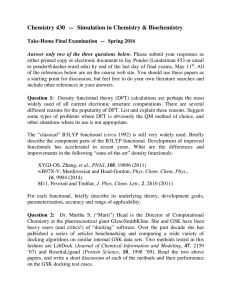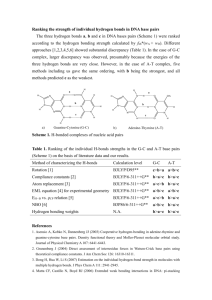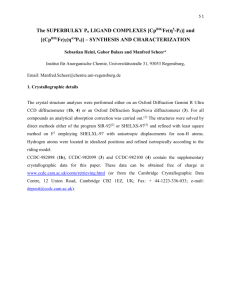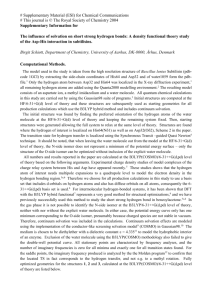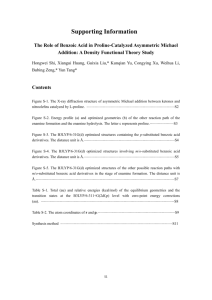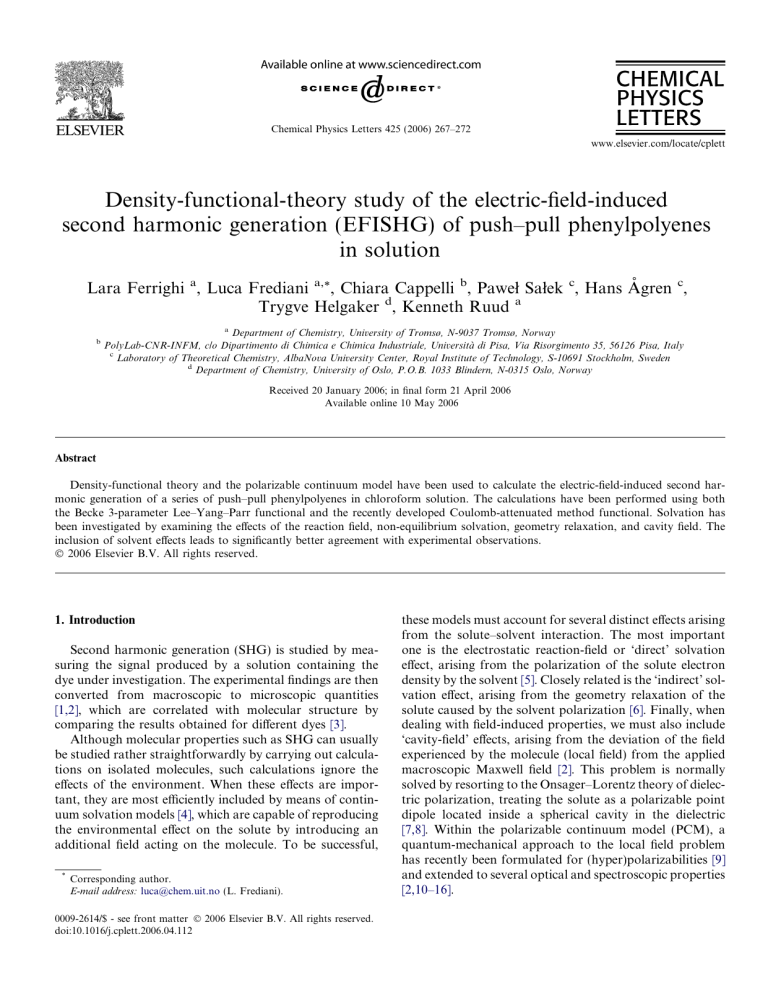
Chemical Physics Letters 425 (2006) 267–272
www.elsevier.com/locate/cplett
Density-functional-theory study of the electric-field-induced
second harmonic generation (EFISHG) of push–pull phenylpolyenes
in solution
Lara Ferrighi a, Luca Frediani a,*, Chiara Cappelli b, Paweł Sałek c, Hans Ågren c,
Trygve Helgaker d, Kenneth Ruud a
b
a
Department of Chemistry, University of Tromsø, N-9037 Tromsø, Norway
PolyLab-CNR-INFM, c/o Dipartimento di Chimica e Chimica Industriale, Università di Pisa, Via Risorgimento 35, 56126 Pisa, Italy
c
Laboratory of Theoretical Chemistry, AlbaNova University Center, Royal Institute of Technology, S-10691 Stockholm, Sweden
d
Department of Chemistry, University of Oslo, P.O.B. 1033 Blindern, N-0315 Oslo, Norway
Received 20 January 2006; in final form 21 April 2006
Available online 10 May 2006
Abstract
Density-functional theory and the polarizable continuum model have been used to calculate the electric-field-induced second harmonic generation of a series of push–pull phenylpolyenes in chloroform solution. The calculations have been performed using both
the Becke 3-parameter Lee–Yang–Parr functional and the recently developed Coulomb-attenuated method functional. Solvation has
been investigated by examining the effects of the reaction field, non-equilibrium solvation, geometry relaxation, and cavity field. The
inclusion of solvent effects leads to significantly better agreement with experimental observations.
! 2006 Elsevier B.V. All rights reserved.
1. Introduction
Second harmonic generation (SHG) is studied by measuring the signal produced by a solution containing the
dye under investigation. The experimental findings are then
converted from macroscopic to microscopic quantities
[1,2], which are correlated with molecular structure by
comparing the results obtained for different dyes [3].
Although molecular properties such as SHG can usually
be studied rather straightforwardly by carrying out calculations on isolated molecules, such calculations ignore the
effects of the environment. When these effects are important, they are most efficiently included by means of continuum solvation models [4], which are capable of reproducing
the environmental effect on the solute by introducing an
additional field acting on the molecule. To be successful,
*
Corresponding author.
E-mail address: luca@chem.uit.no (L. Frediani).
0009-2614/$ - see front matter ! 2006 Elsevier B.V. All rights reserved.
doi:10.1016/j.cplett.2006.04.112
these models must account for several distinct effects arising
from the solute–solvent interaction. The most important
one is the electrostatic reaction-field or ‘direct’ solvation
effect, arising from the polarization of the solute electron
density by the solvent [5]. Closely related is the ‘indirect’ solvation effect, arising from the geometry relaxation of the
solute caused by the solvent polarization [6]. Finally, when
dealing with field-induced properties, we must also include
‘cavity-field’ effects, arising from the deviation of the field
experienced by the molecule (local field) from the applied
macroscopic Maxwell field [2]. This problem is normally
solved by resorting to the Onsager–Lorentz theory of dielectric polarization, treating the solute as a polarizable point
dipole located inside a spherical cavity in the dielectric
[7,8]. Within the polarizable continuum model (PCM), a
quantum-mechanical approach to the local field problem
has recently been formulated for (hyper)polarizabilities [9]
and extended to several optical and spectroscopic properties
[2,10–16].
268
L. Ferrighi et al. / Chemical Physics Letters 425 (2006) 267–272
The basis of the PCM approach to the local field
problem is the assumption that the effective field experienced by the molecule in the cavity can be viewed as the
sum of a reaction-field term and a cavity-field term. The
reaction field is connected to the response (polarization)
of the dielectric to the solute charge distribution,
whereas the cavity field depends on the polarization of
the dielectric induced by the applied field once the cavity
has been created. Moreover, since the external fields of
SHG are time-dependent, we must account for solvent
dynamics by introducing a non-equilibrium formalism
[17,18]. All these effects have successfully been developed
within the framework of the PCM [19] and also in other
continuum models, based on a simpler description of the
cavity [20].
To model optical properties, we must also choose the
level of theory to be used in the description of the electronic
structure of the solute. An efficient and flexible method is
that of density-functional-theory (DFT), provided that an
appropriate functional for the systems under investigation
is available. Here, we used the popular Becke-3-parameter
Lee–Yang–Parr (B3LYP) functional [21,22] together with
the newly developed Coulomb-attenuated-method B3LYP
(CAM-B3LYP) functional [23,24]. The CAM-B3LYP
functional is included since B3LYP is quite reliable for
small and medium-sized systems but it fails for states dominated by a long-range charge-transfer (CT) character [25],
such as those studied here. The B3LYP functional offers a
good description of the training-set molecules and properties for which it was optimized but does not properly
describe certain long-range processes. The CAM-B3LYP
functional improves on this behavior by varying the
amount of exact exchange used for short- and long-range
interactions.
The Letter is organized as follows: the theoretical
method and computational details are outlined in Section
2, the results are presented and discussed in Section 3,
and some concluding remarks are given in Section 4.
In the condensed phase, the corresponding microscopic
quantity to be calculated and compared with experiment
bð!2x; x; xÞ, see Ref. [2]. In the PCM, the effective
is l& ' e
dipole moment is obtained as [15]
oG
;
ð3Þ
oE
where G is the solute free energy and E the Maxwell electric
field in the continuum dielectric. By analogy with Eq. (1),
the elements of e
bð!2x; x; xÞ are defined as
1X e
e
b i ð!2x; x; xÞ ¼
ð b ijj þ e
b jji þ e
b jij Þ;
ð4Þ
5 j
l& ¼
in terms of the effective first hyperpolarizability tensor
components of Ref. [2]:
e
b ijk ð!2x; x; xÞ ¼ !hhlk ; e
li; e
l j iix;x :
ð5Þ
e has been discussed elsewhere
The PCM definition of l
[10,15]. It is expressed in terms of a suitable set of point
charges (the external charges) qex
l , each associated with a
portion (tessera) of the cavity surface
X
oqex
e
ð6Þ
l¼!
V ðsl Þ l ;
oE
l
where V(sl) is the electric potential associated with the
molecular charge density, measured at the center of the
lth tessera sl. The charges are obtained from the usual
PCM relation
qex ¼ !D!1 en ;
ð7Þ
where D is calculated from the optical dielectric constant of
the medium so as to include the non-equilibrium response
of the solvent to the external electric field [18], and en contains the components of the external electric field normal to
the cavity surface [9]. The effective electric dipole moment
l* and the hyperpolarizability e
b contain both reaction
and cavity-field contributions [9,10], representing the
in situ response of the solute to variations in the Maxwell
fields in the medium.
2. Methodology and computational details
2.2. Computational details
2.1. Methodology
The ground-state structures of the molecules investigated were fully optimized in the gas phase at the HF/631G* level and both in gas-phase and chloroform at the
B3LYP/6-31G* level of theory. For the hyperpolarizability
calculations, we used HF, B3LYP, and CAM-B3LYP. For
CAM-B3LYP, two different parameterizations of the functionals have been investigated: using the same notation as
in Ref. [24] the two following sets of parameters have been
employed: a = 0.19, b = 0.46, l = 0.33 and a = 0.19,
b = 0.81, l = 0.30 (for the sake of brevity we will refer to
them as CAM-B3LYP(1) and CAM-B3LYP(2) in the following). The former parametrization is the original one
proposed in Ref. [23], which was found to give the smallest
atomization energy errors for the set of molecules tested.
This parametrization does however not have a fully correct
In EFISHG gas-phase measurements, the observed
quantity is l Æ b(!2x;x,x), where l is the molecular dipole
moment and where the elements of b are related to the
Cartesian components of the first hyperpolarizability tensor bijk(!2x;x,x) as follows:
1X
ðbijj þ bjji þ bjij Þ
ð1Þ
bi ð!2x; x; xÞ ¼
5 j
The hyperpolarizability elements can be expressed in terms
of a quadratic response function with a proper choice of
operators: [26]
bijk ð!2x; x; xÞ ¼ !hhli ; lj ; lk iix;x
ð2Þ
269
L. Ferrighi et al. / Chemical Physics Letters 425 (2006) 267–272
asymptotic behavior. The latter parametrization which was
used in Ref. [24] addresses this deficiency. The parameters
a, b and l are however not fully optimized and this parametrization cannot be recommended for common use. For all
hyperpolarizability calculations the cc-pVDZ basis set [27]
has been used, based on a previous study of solvent effects
on the SHG [28].
The chloroform calculations were carried out with the
quadratic response implementation [28] of the integralequation formalism PCM (IEF-PCM) method [29] in the
Dalton program [30] using the static and optical dielectric
constants !0 = 4.90 and !opt = 2.085. The molecule-shaped
cavity surrounding the solute was built from a set of interlocking spheres placed on the heavy atoms having the following radii: RC = 2.28 Å (for the sp2 carbons), RC = 2.4 Å
(for the sp3 carbons), and RC,N = 2.4 Å (for the carbons
and nitrogens in the cyano group). The vector b(!2x;x,x)
was calculated at a frequency x corresponding to a wavelength of 1.907 lm. All l Æ b values are reported in units
of 1048 esu.
Although the measurements were carried out on analogues where the donor methyl groups were replaced by
butyl groups [31], this should not affect the hyperpolarizability since the electronic structure of the chromophore
is not substantially modified by the longer aliphatic chain.
The accuracy of the measurements is 5%–10%.
3. Results and discussion
In Fig. 1, the structures of the five molecules studied
here are shown. For brevity, we shall refer to these as
N1, N2, N3, N4, and N5, with reference to the number
of double bonds in the polyene chain.
One important parameter in the resulting hyperpolarizability is the so-called bond length alternation (BLA) which
can be defined as the difference between the average lengths
of single and double bonds in the chain. The BLA values
for N3, N4, and N5, calculated from the (–CH@CH–)n!1
part of the polyene chain, are reported in Table 1. It can
be noted that there exists a significant difference between
the obtained BLA values at the HF level in comparison
to the B3LYP analogues. Namely, the HF BLAs show a
substantially higher localization of the double bonds,
whereas the B3LYP BLAs indicate that a higher degree
of conjugation is observed. Another significant difference
between HF and B3LYP, which will play an important role
in the future discussion of the hyperpolarizability results, is
the trend along the series: the HF BLAs increase along the
N3–N5 series wheres the B3LYP BLAs is almost constant
showing a very limited decrease. For what concerns the
CAM-B3LYP functional, geometry optimization is not
yet available. It is worth noticing that whereas HF is
known to yield too localized geometries (higher BLAs),
B3LYP displays the opposite behavior, overestimating
the delocalization [32] (smaller BLAs). It is reasonable to
expect that CAM-B3LYP would yield somewhat intermediate geometries. For a discussion about this aspect in connection to solvation effects see, e.g. Ref [32] and references
therein.
Concerning the solvent effect, which has been investigated at the B3LYP level we have observed a decrease of
around 0.014 Å in the BLA for all molecules with respect
to the gas-phase values, showing a further delocalization
due to solvation, as would be expected. Moreover, in solution the trend along the series is opposite to that observed
in the gas phase. The full set of HF optimizations in solvent
has not been carried out, but a test calculation on N4
shows a similar qualitative solvation behavior as for
B3LYP with a decrease of the BLA of 0.008 Å.
In Table 2, we have listed the calculated l Æ b gas-phase
values of the five molecules. A significant amplification of
the SHG signal along the series is observed. Moreover,
the total increase in l Æ b from N1 to N5 is 47 times for
the B3LYP functional and 34 times for the CAMB3LYP(1) functional, in agreement with the limitations
of B3LYP in reproducing polarizabilities of extended conjugated molecules, especially CT systems, because of its
incorrect long-range behavior [33,34]. As expected, the difference between the functionals is negligible for the smallest
system N1 but significant for N5, where we observe a 30%
lowering of the SHG signal from B3LYP to CAMB3LYP(1). This behavior is consistent throughout the
Table 1
BLA values calculated at the HF/6-31G* level in gas-phase and at the
B3LYP/6-31G* level in gas-phase and in chloroform solution
Molecule
HF gas-phase
B3LYP gas-phase
B3LYP chloroform
N3
N4
N5
0.1042
0.1083
0.1112
0.0554
0.0547
0.0541
0.0407
0.0409
0.0413
Table 2
Gas-phase values of l Æ b phase calculated at B3LYP/cc-pVDZ and CAMB3LYP(1)/cc-pVDZ levels
CH3
N
H3C
CN
CN
n 1
Fig. 1. Molecular structure of the push–pull phenylpolyenes investigated
in the present work (n = 1,5).
Molecule
B3LYP
N1
N2
N3
N4
N5
249.2
876.8
2425.5
5633.5
11842.3
CAM-B3LYP(1)
(3.52)
(2.77)
(2.34)
(2.10)
248.9
826.0
2114.6
4475.4
8412.3
(3.32)
(2.56)
(2.12)
(1.88)
Geometries optimized in the gas phase at the B3LYP/6-31G* level.
Enhancement factors (l Æ b)n/(l Æ b)n!1 are given in parentheses.
270
L. Ferrighi et al. / Chemical Physics Letters 425 (2006) 267–272
series. In order to clarify this aspect and to ease the comparison between experimental values and theoretical predictions, we have also reported ‘enhancement factors’
along the series, defined as the ratio of calculated values
of l Æ b between two consecutive oligomers of the series.
It can be seen that such factors are consistently smaller
for CAM-B3LYP(1) with respect to B3LYP.
In Table 3, we have listed the calculated chloroform values of l& ' e
b for N1–N5 in solution at the HF and CAMB3LYP(1) levels with HF gas-phase geometries and at
the CAM-B3LYP(1), CAM-B3LYP(2), and B3LYP levels
with B3LYP geometries. Since the CAM-B3LYP geometry
is not available, the CAM-B3LYP hyperpolarizability calculations were performed both with HF and B3LYP geometries. Gas-phase geometries have here been employed to
investigate the direct solvation effect. The geometry effect
can be obtained by comparing data in Table 3 with data
in Table 4. The data can be analyzed in two different ways:
on the one hand one can compare the obtained l& ' e
b values with the experimental quantities, on the other hand it
is possible to compare the enhancement factors along the
series. This second parameter is useful to measure to what
extent the chosen method can be used as a predictive tool
when the experiments are unavailable. The experimental
data have been reported in the last two columns of Table 4.
Comparing the HF results in Table 3 with the experimental data it can be seen that l& ' e
b is always severely
underestimated starting from N1. Moreover the enhancement factors are smaller than the experimental ones, thus
leading to a reduction of the observed experimental trends
along the series. The use of CAM-B3LYP(1) with HF
geometries leads to a significant improvement over the
HF results both for absolute values of l& ' e
b and for the
enhancement factors, although the reduction shown by
the HF results is still present if one compares the two last
enhancement factors with the experimental ones (1.70
b for N4 and N5 are
and 1.43 vs. 1.94 and 1.98), and l& ' e
therefore underestimated. This is an indication that the
HF geometries are not adequate and, especially for the
longer chains, they affect the calculated quantities
significantly.
By employing the B3LYP geometries obtained in the gas
phase with the CAM-B3LYP(1) functional, a further
improvement in the absolute values is observed although
the values for N3–N5 now become slightly overestimated.
The comparison of enhancement factors shows that these
also are overestimated, except for the last one.
In order to understand the role of the CAM-B3LYP
parametrization, the CAM-B3LYP(2) has also been tested.
The resulting absolute values are improved compared to
CAM-B3LYP(1) and are in good agreement with the
experimental quantities. The factors along the series are
on average improved compared to CAM-B3LYP(1), apart
from the last one which is now slightly underestimated. In
order to complete this series of calculations, the B3LYP
l& ' e
b have also been included. Although the values for
N1 and N2 are here well reproduced, the trend along the
series leads to a severe overestimation of l& ' e
b. This is
clearly seen by comparing the enhancement factors which
are all significantly overestimated.
The indirect solvent effect has been investigated at the
DFT level, reoptimizing N1–N5 in chloroform solution
with B3LYP and the 6-31G* basis, and performing l& ' e
b
calculations both at the CAM-B3LYP and the B3LYP levels. The results obtained are reported in Table 4. The indirect solvent effect on l& ' e
b at the B3LYP level is very small:
Table 3
Calculated l& ' e
b in chloroform at different levels of theory: HF, CAM-B3LYP(1), CAM-B3LYP(2) and B3LYP
Molecule
N1
N2
N3
N4
N5
HF/6-31G* geometry
B3LYP/6-31G* geometry
HF
CAM-B3LYP(1)
CAM-B3LYP(1)
386.3
913.3
1680.5
2510.3
3283.8
634.3
1903.8
4162.0
7059.1
10120.3
707.7
2394.2
6407.1
13961.6
26733.3
CAM-B3LYP(2)
B3LYP
687.6
725.1
(2.36)
(3.00)
(3.38)
2190.7
(3.19)
2630.4
(3.63)
(1.84)
(2.19)
(2.68)
5414.3
(2.47)
7855.0
(2.99)
(1.49)
(1.70)
(2.18)
10763.7
(1.99)
19759.9
(2.52)
(1.31)
(1.43)
(1.91)
18626.8
(1.73)
45411.4
(2.30)
& e
*
*
The following gas-phase geometries have been employed: HF/6-31G for HF and CAM-B3LYP(1) l ' b and B3LYP/6-31G for CAM-B3LYP(1), CAMe See text for details about the two different CAM-B3LYP parametrization. Enhancement factors along the series are given in
B3LYP(2) and B3LYP l& ' b.
parentheses.
Table 4
Calculated and experimental values of l& ' e
b in chloroform
Molecule
B3LYP
N1
N2
N3
N4
N5
694.6
2516.4
7603.5
19418.1
45620.1
CAM-B3LYP(1)
(3.62)
(3.02)
(2.55)
(2.35)
712.6
2500.7
7035.3
16176.9
32756.6
CAM-B3LYP(2)
(3.51)
(2.81)
(2.30)
(2.02)
713.3
2412.8
7165.0
13576.2
24982.7
Experimental data [31]
(3.38)
(2.97)
(1.89)
(1.84)
880
2720
5660
11000
21800
(3.09)
(2.08)
(1.94)
(1.98)
Theoretical results are obtained with B3LYP, CAM-B3LYP(1) and CAM-B3LYP(2) functionals and the cc-pVDZ basis set. Enhancement factors are
shown in parenthesis. All calculations performed with B3LYP/6-31G* geometries in chloroform. See text for details about the two different CAM-B3LYP
parameterizations.
L. Ferrighi et al. / Chemical Physics Letters 425 (2006) 267–272
the absolute values are only slightly modified and the
enhancement factors are overestimated even further.
CAM-B3LYP(1) results are improved over B3LYP results
along the whole series, although the indirect solvent effect
here leads to a worse agreement with experiment: from
N3 to N5 we observe an overestimation of the experimental
results and moreover all enhancement factors are worse
than their counterparts obtained using the gas-phase geometries. By changing the parametrization of CAM-B3LYP
from (1) to (2) a better agreement with experiment is again
observed, confirming the better behavior of CAMB3LYP(2). It must be noted that also in this case the
indirect solvent effect leads to an overestimation of the
property for N3–N5.
From the comparison of the calculated data in Tables 3
and 4 we can conclude that the DFT results in general are
superior to HF values as expected, both for the l& ' e
b values and the trends along the series. Moreover, B3LYP
geometries are better than HF: this can for instance be seen
by comparing the CAM-B3LYP(1) results obtained with
the HF and B3LYP gas-phase geometries where a significant improvement on the calculated absolute values and
enhancement factors is clearly observed. Another important aspect is shown by the comparison of the two CAMB3LYP parameterizations: namely, parametrization (2)
performs better than parametrization (1) both with gasphase geometries and with chloroform solution geometries.
The indirect solvent effect must be analyzed with special
care. The pure B3LYP l& ' e
b show almost no secondary
solvation effect: this surprising behavior can be rationalized
by examining l* and e
b separately. The dipole moment
increases of about 4% from N1 to N5 upon geometry relaxation whereas the hyperpolarizability partly cancels the
changes arising from l*. The CAM-B3LYP functionals
give an increase of both l* and e
b upon geometry relaxation
along the series which is in better agreement with the
expected variation of the hyperpolarizabilities due to the
reduction of BLA upon solvation.
One important point connected to the indirect solvent
effect concerns the apparent deterioration of the calculated
l& ' e
b at the CAM-B3LYP level upon geometry relaxation.
For both parameterizations, slightly worse results than with
gas-phase geometries are observed. We propose the following rationalization of the observed behavior: the solvent
effect leads to a reduction of the BLA, but the starting gasphase B3LYP geometries are already underestimating the
correct values, and therefore the calculated l& ' e
b at the
CAM-B3LYP level with B3LYP gas-phase geometries benefit from a fortuitous cancellation of errors, thus leading to
better values with respect to solvent-optimized geometries.
Relative to experiment, the CAM-B3LYP(2) values are
within three times the experimental error bars for all molecules both using gas-phase and chloroform geometries (see
Fig. 2). However, the CAM-B3LYP(1) functional gives
values within three error bars for all molecules only when
gas-phase geometries are used, but only for the molecule
N1–N3 when the solvent-relaxed geometries are used.
271
Fig. 2. Comparison of experimental and calculated result for l& ' e
b. The
four sets of calculations correspond to the two different functionals and
the two environments. For the gas-phase, l Æ b is reported.
We end this section by commenting on the cavity-field
factors. The classical analogue of the PCM cavity field factor for EFISHG measurement can be obtained by generalizing the Onsager–Lorentz theory for a spherical cavity to
obtain
!
"2
3!0
3!opt
ð8Þ
lons–lor ¼
2!0 þ 1 2!opt þ 1
This expression is obtained by considering the molecular
responses involved in the definition of the molecular quantities and by associating to each of them a proper cavity
0
factor (in classical #terms).$ In our particular case, 2!3!0 þ1
2
3!
opt
comes from l* and
from e
b, which is a quadratic
2!opt þ1
response in terms of the effective dipole operator (see also
Ref. [15] for a comparison).
lons–lor takes a value of 1.99 for chloroform. The PCM
values, which can be calculated as the ratio
lPCM ¼ l& ' e
b=l ' b depend on the cavity shape and size.
Note that in this formula l and b are calculated by
accounting for the reaction field only. In the sequence from
N1 to N5 at the solvent geometries, the corresponding
ratios are 1.21, 1.15, 1.12, 1.10, 1.09, significantly lower
than the classical values. Moreover, the PCM factor
decreases along the series, whereas the classical value, calculated assuming a spherical cavity, is constant since it only
depends on the solvent. It is important to stress that the
decrease of the cavity factors balances the overestimation
of the property with increasing chain length. The use of
the classical factor would not be appropriate to reproduce
this feature.
4. Summary and conclusions
In this Letter, we have presented a first comparison of
experimental observations with calculated hyperpolarizabilities in solvent with the IEF-PCM model at the DFT
level of theory for a SHG process. We have shown that
272
L. Ferrighi et al. / Chemical Physics Letters 425 (2006) 267–272
the solvent effects are important and must be included to
obtain a satisfactory agreement with experiments. Our
model takes into account direct solvation effects through
the solvent reaction field, indirect solvation effects due to
geometry relaxation, and cavity-field effects to reproduce
the local variation of the fields experienced by the molecule
because of the presence of the surrounding environment.
The observed experimental trends have been satisfactorily
reproduced with the CAM-B3LYP functional, which performs significantly better than the B3LYP functional, especially for the bigger oligomers. However, there are still
some issues to be addressed: we refer in particular to the
role of CAM-B3LYP optimized geometries which are not
available at present and to the validity and reliability of
the different CAM-B3LYP parameterizations. For what
concerns the former, based on the obtained results we have
inferred that B3LYP gas-phase geometries could be used as
a good guess for CAM-B3LYP solvent-optimized
geometries, hence explaining the better agreement with
experiment observed with CAM-B3LYP using B3LYP
gas-phase geometries compared to the ones using B3LYP
solvent-geometries. For the latter, we stress that CAMB3LYP functional has not been thoroughly tested yet,
therefore an ‘optimal’ commonly accepted parametrization
is still under discussion requiring dedicated work which is
beyond the scope of this Letter.
Acknowledgments
This work has been supported by the Norwegian Research Council through a Strategic University Program in
Quantum Chemistry (Grant No. 154011/420), a YFF grant
(Grant No. 162746/V00), and a Ph.D. grant to L. Ferrighi
through the Nanomat program (Grant No. 158538/431). A
grant of computer time from the Norwegian Supercomputing Program is also acknowledged. This work is part of,
and is supported by, the EU-STREP project ODEON
founded by the European Community’s Sixth Framework
Programme. Support from NorFa (Grant No. 030262) is
also gratefully acknowledged.
[3]
[4]
[5]
[6]
[7]
[8]
[9]
[10]
[11]
[12]
[13]
[14]
[15]
[16]
[17]
[18]
[19]
[20]
[21]
[22]
[23]
[24]
[25]
[26]
[27]
[28]
[29]
[30]
[31]
[32]
References
[1] R. Wortmann, D.M. Bishop, J. Chem. Phys. 108 (1998) 1001.
[2] R. Cammi, B. Mennucci, J. Tomasi, J. Phys. Chem. A 104 (2000)
4690.
[33]
[34]
D.R. Kanis, M.A. Ratner, T.J. Marks, Chem. Rev. 94 (1994) 195.
J. Tomasi, M. Persico, Chem. Rev. 94 (1994) 2027.
S. Miertus, E. Scrocco, J. Tomasi, Chem. Phys. 55 (1981) 117.
E. Cances̀, B. Mennucci, J. Chem. Phys. 109 (1998) 249.
L. Onsager, J. Am. Chem. Soc. 58 (1936) 1486.
C.J.F. Böttcher, P. Bordewijk, Dielectric in time–dependent
fieldsTheory of Electric Polarization, vol. II, Elsevier, Amsterdam,
1978.
R. Cammi, B. Mennucci, J. Tomasi, J. Phys. Chem. A 102 (1998) 870.
R. Cammi, C. Cappelli, S. Corni, J. Tomasi, J. Phys. Chem. A 104
(2000) 9874.
S. Corni, C. Cappelli, R. Cammi, J. Tomasi, J. Phys. Chem. A 105
(2001) 8310.
C. Cappelli, S. Corni, B. Mennucci, R. Cammi, J. Tomasi, J. Phys.
Chem. A 106 (2002) 12331.
C. Cappelli, B. Mennucci, J. Tomasi, R. Cammi, A. Rizzo, G.
Rikken, R. Mathevet, C. Rizzo, J. Chem. Phys. 118 (2003) 10712.
C. Cappelli, S. Corni, B. Mennucci, R. Cammi, J. Tomasi, Int. J.
Quantum Chem. 104 (2005) 716.
C. Cappelli, B. Mennucci, R. Cammi, A. Rizzo, J. Phys. Chem. B 109
(2005) 18706.
M. Pecul, E. Lamparska, C. Cappelli, L. Frediani, K. Ruud, J. Phys.
Chem. B 110 (2006) 2807.
H. Kim, J.T. Hynes, J. Chem. Phys. 93 (1990) 5194.
R. Cammi, J. Tomasi, Int. J. Quantum Chem. 29 (1995) 465.
J. Tomasi, B. Mennucci, R. Cammi, Chem. Rev. 105 (2005) 2999.
K.V. Mikkelsen, K.O. Sylvester-Hvid, J. Phys. Chem. 100 (1996)
9116.
A.D. Becke, J. Chem. Phys. 98 (1993) 5648.
P.J. Stephens, F.J. Devlin, C.F. Chabalowski, M.J. Frisch, J. Phys.
Chem. 98 (1994) 11623.
T. Yanai, D. Tew, N.C. Handy, Chem. Phys. Lett. 393 (2004) 51.
M.J.G. Peach, T. Helgaker, P. Sałek, T.W. Keal, O.B. Lutnæs, D.J.
Tozer, N.C. Handy, Phys. Chem. Chem. Phys. 8 (2006) 558.
A. Dreuw, J.L. Weisman, M. Head-Gordon, J. Chem. Phys. 119
(2003) 2943.
J. Olsen, P. Jørgensen, in: D.R. Yarkony (Ed.), Modern Electronic
Structure Theory, Part II, p. 857, World Scientific, Singapore, 1995.
D.E. Woon, T.H. Dunning jr., J. Chem. Phys. 100 (1994) 2975.
L. Frediani, H. Ågren, L. Ferrighi, K. Ruud, J. Chem. Phys. 123
(2005) 144117.
E. Cancès, B. Mennucci, J. Math. Chem. 23 (1998) 309.
dalton, a molecular electronic structure program, Release 2.0, 2005.
Available from: <http://www.kjemi.uio.no/software/dalton/dalton.
html>.
V. Alain, L. Thouin, M. Blanchard-Desce, U. Gubler, C. Bosshard, P.
Günter, J. Muller, A. Fort, M. Barzoukas, Adv. Mater. 11 (1999)
1210.
S. Corni, C. Cappelli, M.D. Zoppo, J. Tomasi, J. Phys. Chem. A 107
(2003) 10261.
B. Champagne, E.A. Perpete, D. Jacquemin, S.J.A. van Gisbergen,
E.J. Baerends, C. Soubra-Ghaoui, K.A. Robins, B. Kirtman, J. Phys.
Chem. A 104 (2000) 4755.
D.P. Tew, T. Yanai, N.C. Handy, Chem. Phys. Lett. 393 (2004) 51.

